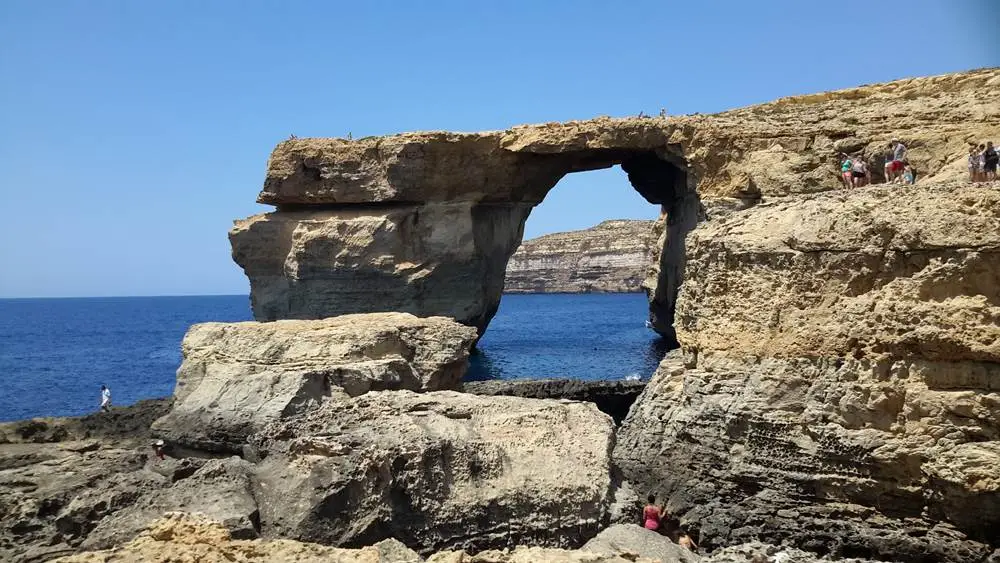Formation of the arch
The Azure Window developed through sea erosion of a cliff face. The progress starts with an initial notch resulting from wave action. It is not known exactly when the arch came to being, but the entire process is believed to have taken around 500 years.
The arch is not mentioned in 17th- and 18th-century descriptions of the Dwejra area, which was already famous due to the nearby Fungus Rock, so it probably did not exist then.
The entrance to the Inland Sea, called the Azure Window in 17th- and 18th-century sources. The natural arch may have inherited its name from this cave
Throughout the 20th and early 21st centuries, the arch was one of Malta’s main tourist landmarks, and it was a popular backdrop in photographs. It was included in a Special Area of Conservation, and in 1998, included on Malta’s tentative list of UNESCO World Heritage Sites, along with the rest of Dwejra Bay.
Deterioration and partial collapses
Between the 1980s and the 2000s, parts of the top slab of the arch collapsed, significantly widening the arch. A large slab of rock on the outer edge of the cavity collapsed in April 2012, further increasing the size of the window. Another rock fall occurred in March 2013. Four months later a geological and geotechnical report was prepared by consultant Peter Gatt, who represented local firm Geoscience Consulting Ltd, and it determined that the arch was “relatively stable and will continue to remain so for a number of years”, and that there was no “imminent” risk of collapse, although it warned that rock falls will continue and it might be hazardous for people to go close to the arch.
Further rock falls and fissures were reported in subsequent years. Fishermen avoided going near the arch with their boats, and warning signs were put up to discourage people from walking on top. However, many people still went on the arch regularly, and videos were uploaded on YouTube of people cliff diving from the window as rocks were falling down.
In March 2016, Gatt warned that the illegal use of explosives at the nearby Inland Sea could have an effect on the already weak structure of the nearby Azure Window. These comments were made in the wake of an investigation by the Malta Environment and Planning Authority which revealed that explosive material was “probably used” to do rock cutting in the tunnel leading to the Inland Sea. It was suspected that the illegal cutting was aimed at widening the entrance to allow larger boats to sail through.
Final collapse
It was actually on Wednesday morning, 8 March 2017 when one of Gozo’s most iconic spots, the Azure Window at Dwejra bay collapsed. Strong winds and big waves which hit the island last year caused this collapse and huge loss for Gozo and all its locals and visitors.
Yes, unfortunately it was true. Nature carved it and nature took it back!
Social media and media channels put the Azure Window sad story in their top of the headline news.
Prime Minister Joseph Muscat and Leader of the Opposition Simon Busuttil both tweeted about the collapse of the Azure Window, and it also became the subject of many Internet memes on Maltese social media.The Environment and Resources Authority called the collapse a major loss to Malta’s natural heritage.
The atmosphere on Gozo was a very sad one. The Azure Window was part of us – losing it was and still feels like a beloved person who passed away.
Aftermath
The government stated that the rock formation will not be rebuilt.
In late 2018, the Russian architect Svetozar Andreev of Hoteì Russia, in collaboration with Elena Britanishskaya, announced a proposal to construct a steel structure on the site of the Azure Window. Andreev said his studio was ready to discuss the project with the Maltese government. “The objective is to compensate for the loss of the Azure Window and create a centre of attraction in Dwejra, a new asset to draw tourists, this time to a new architectural and cultural landmark.”
Apart from having five floors for exhibition space, Andreev has proposed a laser show in which each spiral step will represents one thousand years of Maltese history.
This proposal drew mixed reactions from the public. Most respondents to online polls were in favour. However, the project has also been criticized since the area is a marine park and the intervention would destroy the underwater remains of the original Azure Window.
In August 2019, a new street in the nearby village of San Lawrenz was named Triq it-Tieqa tad-Dwejra (Dwejra Window Street) in memory of the natural landmark.



